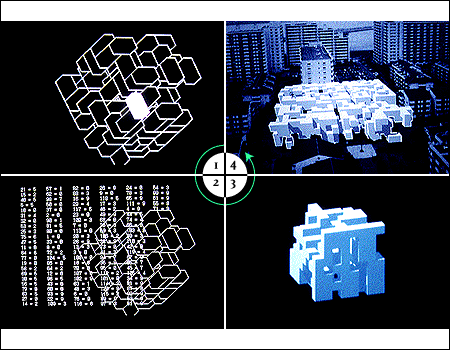 FULL TEXT
FULL TEXT
 The City of the Sun God
The City of the Sun God

Computer combines units at random and sends sunlight toeach. This process is repeated automatically until all the units are arranged.
In studying the arrangement of units for multi-unit housing architecture, access to maximum
sunshine for each unit is given top priority in Japan. The result is monotonous box-like
housing complexes everywhere. Some attempts have been made to devise innovative shapes, but
the basic structure remains roughly the same.
Are these shapes really the optimal solution? The requirement is that each unit receives
sunlight for a certain length of time, so we put aside for the time being the standard answer that
a building be constructed far enough away from the nearest building that no shadow extends to
it.
First of all, we erect a large cubic structure to aprescribed height filling the building site to
its limits. Then we cut tunnels in the structure so that sunlight reaches the back-side units. We
do the same thing for all the other units that do not have adequate access to sunlight. The result
is the emergence of a huge "porous cube," a building with numerousvoids.
The way the units are connected varies, and great diversity of space and form emerges. The
very simple code, "X hours of sunshine for each unit," produces an entity of diversity.
Here we developed a computer program that performs this task automatically. It reveals that
the standardized method of arranging units is not the only or the best, but merely one ofmany
solutions. The solution we discovered suggests a richly variety external space with diverse
indentations, providing new relations between function on the one hand and space (e.g.,openings,
yards, paths, terraces, and common spaces on the other. They also afford great flexibility in the plan.
This study focuses on the single condition--sunshine--and on the primary shape--cube--for
the arranged units. It is quite easy to change the unit shapes. This method can also be applied to
create automatic programs for other important conditions, such as privacy and access. Limits
can also be imposed on the size of voids and their relation to the dwelling units. In this way,
it is possible to guide the results as desired.
 Title Page
Title Page
| No.12 Contents |
Internet Edition Contents |
| Magazines & Books Page | |